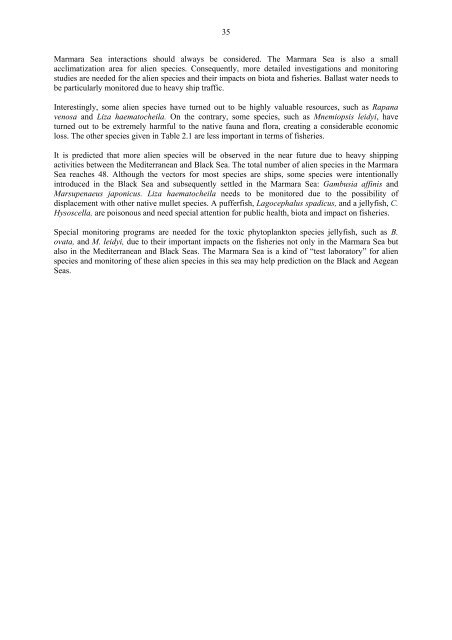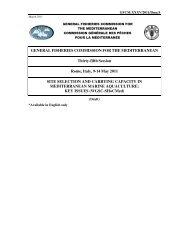Status of alien species in the Mediterranean and Black Sea
Status of alien species in the Mediterranean and Black Sea
Status of alien species in the Mediterranean and Black Sea
Create successful ePaper yourself
Turn your PDF publications into a flip-book with our unique Google optimized e-Paper software.
35<br />
Marmara <strong>Sea</strong> <strong>in</strong>teractions should always be considered. The Marmara <strong>Sea</strong> is also a small<br />
acclimatization area for <strong>alien</strong> <strong>species</strong>. Consequently, more detailed <strong>in</strong>vestigations <strong>and</strong> monitor<strong>in</strong>g<br />
studies are needed for <strong>the</strong> <strong>alien</strong> <strong>species</strong> <strong>and</strong> <strong>the</strong>ir impacts on biota <strong>and</strong> fisheries. Ballast water needs to<br />
be particularly monitored due to heavy ship traffic.<br />
Interest<strong>in</strong>gly, some <strong>alien</strong> <strong>species</strong> have turned out to be highly valuable resources, such as Rapana<br />
venosa <strong>and</strong> Liza haematocheila. On <strong>the</strong> contrary, some <strong>species</strong>, such as Mnemiopsis leidyi, have<br />
turned out to be extremely harmful to <strong>the</strong> native fauna <strong>and</strong> flora, creat<strong>in</strong>g a considerable economic<br />
loss. The o<strong>the</strong>r <strong>species</strong> given <strong>in</strong> Table 2.1 are less important <strong>in</strong> terms <strong>of</strong> fisheries.<br />
It is predicted that more <strong>alien</strong> <strong>species</strong> will be observed <strong>in</strong> <strong>the</strong> near future due to heavy shipp<strong>in</strong>g<br />
activities between <strong>the</strong> <strong>Mediterranean</strong> <strong>and</strong> <strong>Black</strong> <strong>Sea</strong>. The total number <strong>of</strong> <strong>alien</strong> <strong>species</strong> <strong>in</strong> <strong>the</strong> Marmara<br />
<strong>Sea</strong> reaches 48. Although <strong>the</strong> vectors for most <strong>species</strong> are ships, some <strong>species</strong> were <strong>in</strong>tentionally<br />
<strong>in</strong>troduced <strong>in</strong> <strong>the</strong> <strong>Black</strong> <strong>Sea</strong> <strong>and</strong> subsequently settled <strong>in</strong> <strong>the</strong> Marmara <strong>Sea</strong>: Gambusia aff<strong>in</strong>is <strong>and</strong><br />
Marsupenaeus japonicus. Liza haematocheila needs to be monitored due to <strong>the</strong> possibility <strong>of</strong><br />
displacement with o<strong>the</strong>r native mullet <strong>species</strong>. A pufferfish, Lagocephalus spadicus, <strong>and</strong> a jellyfish, C.<br />
Hysoscella, are poisonous <strong>and</strong> need special attention for public health, biota <strong>and</strong> impact on fisheries.<br />
Special monitor<strong>in</strong>g programs are needed for <strong>the</strong> toxic phytoplankton <strong>species</strong> jellyfish, such as B.<br />
ovata, <strong>and</strong> M. leidyi, due to <strong>the</strong>ir important impacts on <strong>the</strong> fisheries not only <strong>in</strong> <strong>the</strong> Marmara <strong>Sea</strong> but<br />
also <strong>in</strong> <strong>the</strong> <strong>Mediterranean</strong> <strong>and</strong> <strong>Black</strong> <strong>Sea</strong>s. The Marmara <strong>Sea</strong> is a k<strong>in</strong>d <strong>of</strong> “test laboratory” for <strong>alien</strong><br />
<strong>species</strong> <strong>and</strong> monitor<strong>in</strong>g <strong>of</strong> <strong>the</strong>se <strong>alien</strong> <strong>species</strong> <strong>in</strong> this sea may help prediction on <strong>the</strong> <strong>Black</strong> <strong>and</strong> Aegean<br />
<strong>Sea</strong>s.
















